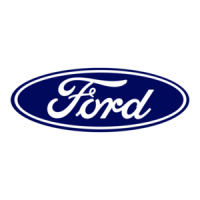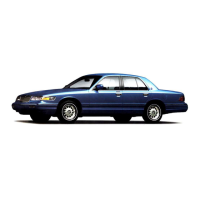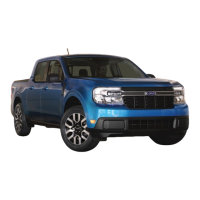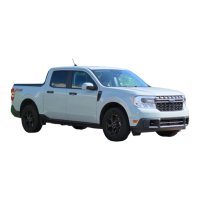
Do you have a question about the Ford Mariner and is the answer not in the manual?
| Brand | Ford |
|---|---|
| Model | Mariner |
| Category | Automobile |
| Language | English |
Explains warning symbols and their importance for vehicle operation and safety.
Guidance on initial driving to ensure proper vehicle break-in and component longevity.
Covers important information like new vehicle warranty and special operating instructions.
Details service and event data recording capabilities of the vehicle's systems.
Discusses safe and responsible use of mobile communication devices while driving.
Alerts you to vehicle conditions that may require attention.
Indicates potential engine issues or the need for inspection/maintenance.
Alerts to low brake fluid or a brake system malfunction.
Indicates status of Anti-lock Brake System and Airbag Supplemental Restraint System.
Explains lights for safety belt, charging, oil pressure, AdvanceTrac, and tire pressure.
Covers lights for low fuel, speed control, anti-theft, door ajar, and lights.
Displays vehicle speed, engine coolant temperature, odometer, and fuel level.
Alerts to vehicle problems and conditions with messages and chimes.
Details the AM/FM, CD, MP3, and satellite compatible sound system.
Instructions on how to set the vehicle's clock display.
Covers AM/FM tuning, seek, scan, presets, and CD/MP3 player functions.
Information on SIRIUS radio, channels, reception, and features like channel lockout.
Connects portable music players to the audio system for playback.
Allows connection of media playing devices and charging via USB port.
Operates manual heating and air conditioning functions.
Details fan speed, defrost, air distribution, and recirculated air controls.
Control for driver and passenger heated seats, if equipped.
Provides advice for defogging and humidity control.
Manages automatic temperature, fan speed, and air distribution.
Explains AUTO, defrost, air distribution, and MAX A/C functions.
Control for driver and passenger heated seats, if equipped.
Advice for maximum cooling and defogging in cold weather.
How to activate and deactivate the rear window defroster.
Operates headlamps, parking lamps, and autolamp system with delay.
Controls headlamps, parking lamps, and autolamp system with delay.
Controls for fog lamps and high beam headlamps.
Features for DRLs and using headlamps for signaling.
Adjusts brightness of instrument panel and interior lighting.
Procedure for vertical adjustment of headlamp beams.
Controls for interior overhead and cargo area lighting.
Controls for interior overhead and cargo area lighting.
Operation of the customizable ambient lighting feature.
Provides trade numbers for various exterior and interior bulbs.
Controls windshield wipers, washers, and manual steering wheel adjustment.
Controls windshield wipers, washers, and courtesy wipe feature.
Operation of rear wiper/washer controls and manual steering wheel adjustment.
Procedure for adjusting the steering column tilt for driver comfort.
Details manual and automatic interior mirrors and power/blind spot exterior mirrors.
Details manual and automatic dimming interior rear view mirror features.
Covers power side view mirrors, blind spot mirrors, and fold-away mirrors.
Operation of heated mirrors, typically linked to rear window defrost.
Instructions for setting, increasing, reducing, and disengaging speed control.
Instructions for setting, increasing, reducing, and disengaging speed control.
Includes notes on steep hills, brake pedal use, and resuming set speed.
Covers moon roof, garage opener, liftgate, cargo, and roof rack.
How to open, close, and use bounce-back features of the moon roof.
Programming the Car2U system for garage doors and home devices.
Instructions for opening and closing the liftgate and liftgate window.
Covers cargo shade installation and operation.
Guidelines for adjusting and removing roof rack cross-bars.
Covers vehicle keys, MyKey system, SecuriLock, and spare key programming.
Functions as ignition key and remote entry transmitter.
Restricted driving modes, settings, and programming of MyKey™.
Engine immobilization system using coded keys.
Procedure to program new Integrated Keyhead Transmitters.
Covers power door locks, autolock, autounlock, and keyless entry.
Controls for unlocking/locking doors via power door lock switch and autolock feature.
Operation of remote entry system, including two-step and one-step unlocking.
Using keypad for access, autolock/autounlock, and programming personal codes.
Mechanism to prevent rear doors from opening from the inside.
Covers manual/power seat adjustment, head restraint, and heated seat controls.
Covers manual and power seat adjustment, and head restraint adjustment.
Operation and safety precautions for heated seats, if equipped.
Adjusting second row head restraints and folding/returning seats.
Adjusting second row head restraints and folding/returning seats.
Procedure to remove and install the second row seat cushion.
Explains Personal Safety System, side airbags, Safety Canopy, and post-crash alerts.
Explains the integrated system of airbags, belts, and sensors.
Information on side airbag deployment and safety canopy system.
System that activates hazard flashers and horn after a serious impact.
Covers child restraint precautions, recommendations, and installation.
Important safety warnings and recommendations for child restraint use.
Guidance on selecting appropriate restraints based on child's size and age.
Steps for installing child seats using LATCH anchors and seat belts.
Guidance on when and how to use booster seats.
Covers tire grading, terminology, inflation, inspection, and alignment.
Details uniform tire quality grading (Treadwear, Traction, Temperature).
Glossary of tire terms including load index, speed rating, and DOT numbers.
Proper tire inflation, inspection for wear, damage, and valve stems.
Importance of tire rotation and wheel alignment for wear and performance.
Explains TPMS function, low tire pressure telltale, and malfunction indicator.
Explains TPMS function, low tire pressure telltale, and malfunction indicator.
Precautions for changing tires to avoid damaging the TPMS sensor.
Guidelines and warnings for using temporary spare tires.
Covers vehicle loading capacity, trailer towing, and preparation.
Determining payload, cargo weight, and axle/vehicle weight ratings.
Information on GCWR, trailer weights, preparing for towing, and hitches.
Recommendations and guidelines for using snow tires and traction devices.
Details ignition key positions, starting procedures, and cold weather tips.
Details ignition key positions and steps for starting the engine.
Tips for starting in cold weather and using the engine block heater.
Safety precautions regarding carbon monoxide in exhaust fumes.
Covers brake system operation, warning lights, ABS, and parking brake.
Information on normal brake noise, dust, ABS, and brake warning lights.
How to use the Anti-lock Brake System and set the parking brake.
Details AdvanceTrac, RSC, TCS, and ESC features.
Details stability enhancement features like TCS, ESC, and RSC.
Explanation of how TCS and ESC function to maintain vehicle control.
System to detect and mitigate trailer sway.
Covers steering, transmission, parking assist, and camera systems.
Information on the EPAS system and steering feel.
Pre-drive checks and the brake-shift interlock feature.
Details adaptive learning, gearshift positions, and grade assist.
Warns of obstacles when reversing using audible tones.
Provides a video image behind the vehicle for assistance while reversing.
Automated parallel parking assistance system.
Integrated mirrors to increase visibility along the side of the vehicle.
Details the intelligent 4WD system's operation and capabilities.
Principles for driving on various terrains and in adverse conditions.
Overview of complimentary roadside assistance services and coverage.
Information on coverage periods and services provided.
Instructions for using the service and reimbursement information.
Location and operation of the hazard flasher control.
Procedure to reset fuel pump switch and identify fuses/relays.
Procedure to reset the fuel pump shut-off switch after an accident.
Explains fuse ratings, colors, and protected circuits in the vehicle.
Step-by-step guide for changing a flat tire safely.
Step-by-step guide for changing a flat tire safely.
Instructions for removing, stowing the jack, tools, and spare tire.
Specifies the correct torque for tightening lug nuts after wheel installation.
Guide for jump starting a vehicle and wrecker towing procedures.
Detailed guide on connecting jumper cables and jump starting.
Recommended towing methods and precautions for FWD, AWD, and 4WD vehicles.
Guidance on getting warranty repairs performed by authorized dealers.
Resources for locating the nearest authorized dealer when traveling.
Information on BBB AUTO LINE, California rights, and Canadian CAMVAP.
Information on BBB AUTO LINE program for warranty disputes.
Details consumer rights regarding vehicle repair and replacement in California.
Information on utilizing the CAMVAP program for vehicle service concerns.
Procedures for reporting vehicle safety defects to NHTSA and Transport Canada.
How to inform NHTSA about potential vehicle safety defects.
Procedure for informing Transport Canada about vehicle safety defects.
Guidelines for washing, waxing, and drying the exterior, including chrome.
Guidelines for washing the vehicle with approved shampoos and drying.
Recommendations for waxing, paint chip touch-ups, and cleaning aluminum wheels.
Instructions for cleaning and maintaining exterior chrome surfaces.
Procedures for cleaning engine compartments and plastic exterior parts.
Steps for cleaning the 2.5L I4 and 3.0L V6 engines safely.
How to clean plastic exterior parts, windows, and wiper blades.
Methods for cleaning instrument panel, interior trim, fabric, carpet, and leather.
Cleaning the instrument panel, interior trim, and cluster lens.
Methods for cleaning interior fabrics, carpets, and leather seats.
List of recommended Motorcraft products for vehicle cleaning.
Covers service recommendations, safety precautions, and engine compartment identification.
Guidance on recommended service intervals and using authorized dealers.
Safety guidelines for working on the vehicle with the engine on or off.
Diagrams and labels for components in the 2.5L I4 and 3.0L V6 engine compartments.
Diagrams and labels for components in the 2.5L I4 and 3.0L V6 engine compartments.
Details washer fluid, wiper blades, engine oil, battery, coolant, and fuel filter.
Checking, adding, and using the correct washer fluid for all seasons.
Instructions for changing wiper blades for optimal performance.
Checking and adding engine oil, and oil/filter recommendations.
Information on battery maintenance, cleaning, and safety precautions.
Checking and adding engine coolant, and fail-safe cooling information.
Information on the lifetime fuel filter and running out of fuel.
Covers fuel economy, driving habits, and emission control systems.
Tips for measuring and improving fuel economy through driving habits.
Information on vehicle's EPA fuel economy estimates and comparisons.
Ensuring proper function of emission control components and catalytic converter.
Checking brake fluid and automatic transmission fluid levels.
How to check brake fluid level and when to seek service.
Procedure for checking transmission fluid level at normal operating temperature.
Lists part numbers, capacities, and specifications for fluids and filters.
Lists part numbers for air filter, battery, oil filter, and spark plugs.
Details capacities and specifications for various vehicle fluids and lubricants.
Provides engine specifications and diagrams for drivebelt routing.
Information on Safety Compliance Certification Label and transmission codes.












